Professionalism Large-Scale Mixing Vessels, Balancing Quality and Cost. Behind the scenes of manufacturing undertaken from a global perspective
01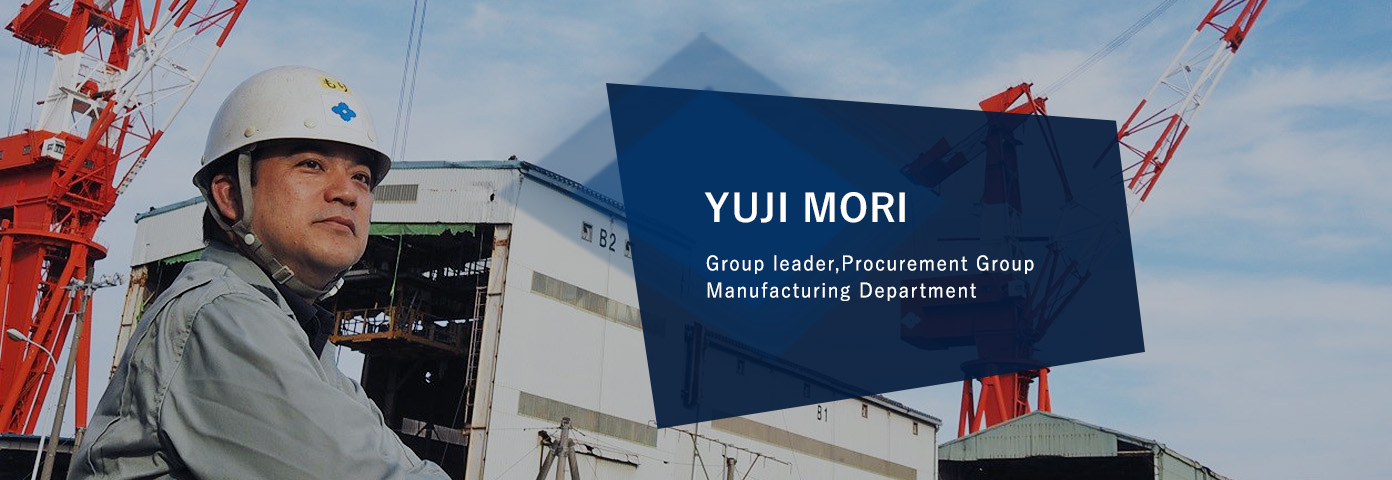
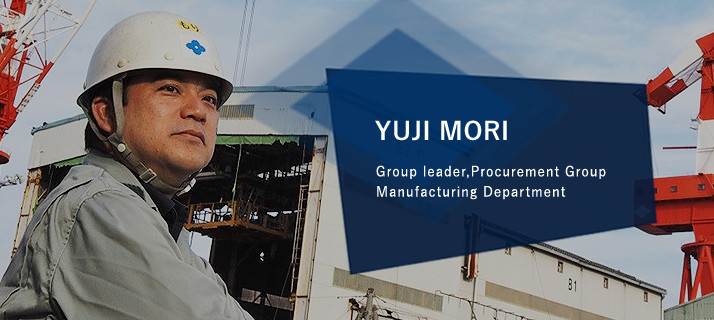
With many years of efforts, we have accumulated a lot of manufacturing experience even in large mixing vessels exceeding 100 m3. Moreover, since 2001, by promoting collaboration with partner companies in South Korea and China, which have the world's largest manufacturing capacity, we have come to achieve super-large vessel manufacturing that weigh as little as 500 tons, and to meet various needs.
We interviewed Mr. Mori from the Manufacturing Department, one of the team members who led the initiative, to know an overview of our large-scale capability and the benefits it brings to our customers.
We never say "We can't do it"
in response to any large mixing vessel requests.
Let me give you an example that I found very impressive. It was the first job I was assigned in 1994 when I joined the company. It was a 200 m3 class mixing vessel for a domestic chemical manufacturer's overseas joint venture factory. It was a tall vessel; 4 meters in diameter, 25 meters in height, and about 420 tons in weight.
Right. When the capacity reaches 100 m3, we consider it big. I found this project very impressive since it was my first assigned job.
The tank of the mixing vessel was produced here (Saijo Factory, Japan). Because it was quite a long, large tank, we divided the parts every few meters and joined them all in order, in consideration of the characteristics and manufacturability of the equipment. It was quite a tough job.
There is another reason why I found this tank very impressive: I made the same type of tank twice after that. One was in 2006 and the other one was undertaken from 2016 to 2017. Since the customers' plants are located all over the world, the delivery destinations varied, but the specifications of the tanks were basically the same. However, there are some distinctive differences between the tank produced in 1994 and the two subsequent ones.
Not at all, haha. Actually, the first tank was manufactured in Japan, but the subsequent ones were manufactured in South Korea. Apart from the fact that our company's design staff formulated the basic specifications, we outsourced the project to our Korean partner company as a total package from detailed design to production.
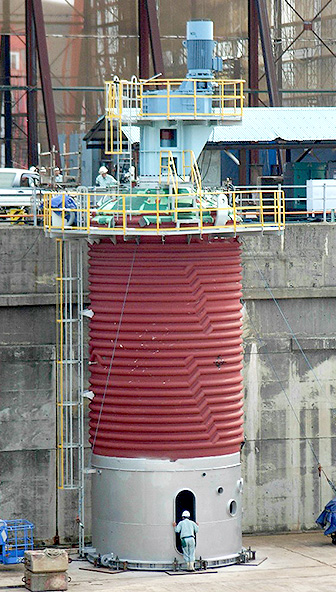
Example of large-scale mixing vessel (approx. 100m3) What protrudes to the top is a driving device that rotates the mixing impellers. It is clear how big it is when you look at the staff at the bottom of the photo.
Until 2000, we had been manufacturing tanks in Japan. However, as seen in the previous case, there was an increasing demand for big tanks from the 1990s. Unfortunately, there are limited factories that can be manufactured in Japan. We make a mixing vessel laid sideways first and then roll it on the roller to finish it. As a result, large-scale equipment is required to handle large weight structures.
That's why the tank that was produced in 1994 was made at the Saijo Factory, but the problem was that manufacturing at our factory would be costly.
While we had these concerns, equipment has become larger. This was a worldwide trend that we were also experiencing at that time. By simply unifying the mixing process that had been operated in two tanks into a single one, the amount of piping and equipment can be drastically reduced, achieving significant benefits in term of operations and costs.
That is why we looked at overseas pressure vessel manufacturers. It was really a new experience for us at the time. We realized that such a big vessel can be made normally at this price. This came as quite a surprise to us. By making the best use of that advantage, we started investigated whether it is possible to manufacture a mixing vessel which has a special specification as an agitator but still remains a pressure vessel.
As a result, we never say, "We can't do it," even when we receive a request for large vessels. We try to find a solution, asking ourselves questions such as, "Can that factory in China do it?" "It may be feasible if we modify that facility in South Korea." From such a broad perspective, we have come to offer the best solution, keeping costs as low as possible.

Is a mixing vessel of made-in-Japan really the best choice?
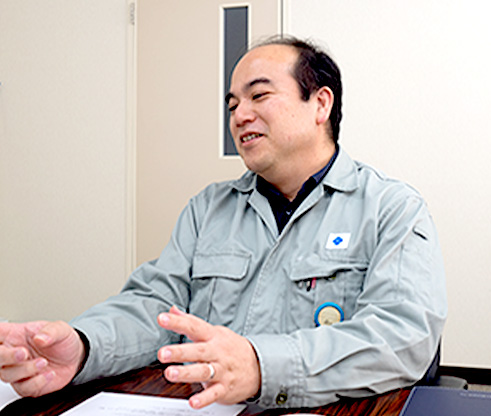
We have delivered tanks manufactured in South Korea and China to many customers now, but at the beginning of the effort, we received a range of opinions and concerns. These came not only from our customers, but also from within the company. There were really many things, haha.
Of course, due to interacting directly with overseas, we experienced one culture shock after another at the beginning.
Checking at the design document we received, it was so different from our way of writing that we couldn't figure out what it was, and we asked, "What kind of document is this?" Or even when we actually saw the completed product, we said, "How can you make it like this? Amazing." Even taking a material, for example, it has a different name and standard number from that of JIS. We had no idea what the 516 was for!
However, thanks to our buildup efforts, even for overseas standards, say SA 240, we now say, "Oh, that one," and we are able to understand easily without translation.
Tanks have been manufactured abroad, and it is obvious that we are making them based on overseas standards. We are now able to talk to the overseas staff on the same wavelength. Today, we regard the ability to respond overseas as one of our strengths, but I think that we have reached this level because of our efforts.

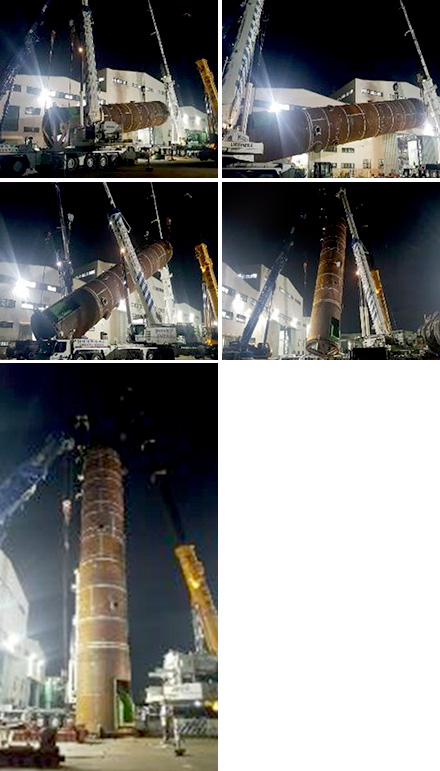
A mixing vessel is "put up"
There are two points that are very different between pressure vessels and mixing vessels. First of all, for mixing vessels, it is essential to polish the inside of the mixing vessel. In order to reduce fouling and dirt, it is necessary to thoroughly mirror finish it. We have a particularly hard time when dealing with a large tank. Once it is assembled it cannot be reversed or rolled easily, so the workers cannot reach inside and end up getting stuck. That's why, before assembling it, we have to polish up each part, including every single bolt. Of course, those polished bolts become scratched if they are assembled, and if you weld the parts, there are weld marks on them. We refine such things afterwards by doing everything possible.
Our partner companies in South Korea and China are mainly manufacturers who make pressure vessels that do not require such consideration. I found it a real struggle to get them to understand what level is meant by "polish thoroughly."
Another thing is that a mixing vessel is something "to be put up after manufacturing." When assembling a pressure vessel, it usually goes to shipment in the direction it is already facing, but it cannot be shipped unless the mixing vessel is pulled up 90 degrees and operation tested. When this is the case for a large mixing vessel, the difficulty is very high. How can we safely pull up things with a weight of hundreds of tons that are very long? It is necessary to carry out the manufacturing process while considering this setup. It is not an easy thing to do.
Besides this, there are many other points, but we have delivered many large structures, and we have extensive expertise that we have obtained as a result. In fact, some engineering companies build equipment using overseas equipment manufacturers. We can say that we were able to overcome the challenges while building relationships of trust with our partner companies by generously sharing our expertise because we own factories and our manufacturing technology.
In addition, even if you refer to technical guidance, there are things that we Japanese people do not communicate well either. If you are a foreigner with a different language and culture, this is even more the case. Accordingly, in terms of communication, we try to talk based on common-sense ideas as much as possible and knowledge of mechanical engineering as found in university textbooks. Sometimes we need to express strange thoughts, but they are not readily accepted if you talk at cross-purposes. As a result, when we want to move on the next development, that approach often works well.
In the past 16 years, we have overcome many difficulties. Almost nothing surprises me now, haha. However, the most important thing is that there is absolutely no difference between the tanks manufactured by our company and those manufactured by our partner companies.
To achieve this, we do not think of them as a subcontractor from whom we simply request manufacturing, but we have been building a relationship of trust as a true partner with whom we can keep in touch forever. Since we communicate with them closely in multiple situations, from meetings at the start of manufacturing to regular checks, visits, and up until the delivery of the product to our customers, we are absolutely confident of what we will deliver to our customers.
It is a fact that some of our customers still say that they will accept nothing but a Japanese-made tank. However, I can say with confidence that "Made in China" or "Made in Korea" is not something like "you get what you pay for." I hope that people will understand that the result achieved by spending a lot of time teaching extensive expertise and devoting ourselves to this is that the tank itself is manufactured overseas.
Achieving a Win-Win-Win relationship between our customers, overseas partners and our company will result in even better value.
It has been 16 years since we began working on large-scale mixing vessel manufacturing. I feel that the equipment requested by our customers is now even bigger and heavier. And the center of the needs for large equipment is clearly shifting to overseas. It is no longer a surprise that the tanks produced in South Korea and China using our technology are assembled into a mixing equipment at their factory, commissioned and delivered directly to overseas customers' plants without having to touch Japanese soil.
This provides significant advantages in addition to cost, and it is a very smart approach from the point of logistics that things manufactured abroad are delivered overseas as they are. In addition, because large unexpected risks, such as delays due to operation restrictions and accidents during transportation, are lurking in the transportation of large equipment, we can also keep them to a minimum. Furthermore, although we use cargo ships when delivering to our customers overseas, unfortunately in recent years, it is a fact that more international ports in South Korea and China are capable of allocating ships than international ports in Japan, which results in no waste in terms of the delivery scheme. You could also say that it is a perfect match.
Considering these consequences, it can be said that our decision at the time to look overseas for large-scale equipment manufacturing was a perfect choice.
In other words, the strength from the aspect of our large-scale countermeasure of the present is to effectively utilize the expertise and technology cultivated at the headquarters factory in Japan to enhance the ability of our partner company. I believe that this is how we are sending out valuable products to customers.
On the other hand, from the viewpoint of the future, I think it is expected that customer needs will become more cost sensitive and that higher quality is required. We must respond to it anyway. Utilizing the expertise we have built up based on our relationships with our overseas partners, we need to find our next partner company with greater price competitiveness, which may be found in inland China, for example. In addition, I think we need to make efforts to increase their capabilities more actively so that the companies with which we currently have partnerships will achieve even higher levels of output.
I think about this constantly. It can be referred to as a "benefit for three sides or good for everybody." That is, our customers will have a sense of security that if they ask Sumitomo, they may be able to manage some difficult tasks. To the partner company, it provides opportunities for technical improvements and business opportunities. To our company, we receive orders for larger projects and new projects, using the facilities and skills of the partner companies. I hope that we can continue to move on with the Win-Win-Win relationship.
Respect each other to build a long-lasting business. With this in mind, we will continue to take on challenges in the future so that we will be able to further enhance our large-scale manufacturing capability that is beneficial for three sides, or good for everybody.
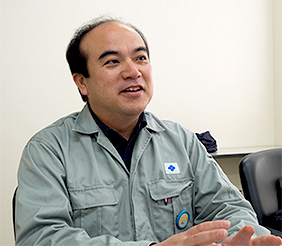
Our Professionals
Sumitomo Heavy Industries Process Equipment Co., Ltd.
Group leader,
Procurement Group, Manufacturing Department
Joined the company in 1994.
Majored in production mechanical engineering at university. Since joining the company, he has been engaged in working at production sites for equipment, mainly agitators and mixing vessels, including industrial technology, undertaking technical teaching to our partner companies both in Japan and overseas, and carrying out installation/repair instruction at customer sites.
He is currently working as a leader of the procurement group, taking advantage of years of negotiation experience with factories and partner companies both in Japan and overseas.

